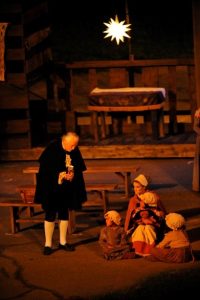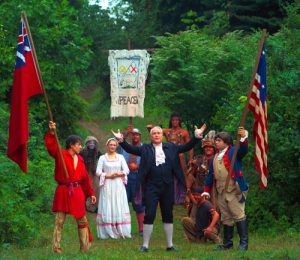In the last article I explored the history of the trumpet in the Moravian Church; playing with words, today the focus is on how we today trumpet our history. This will take us far across the sea and bring us home to Fulneck. So, settle down for a journey of discovery and of the well-known.
When I first went to Fulneck Church I was amazed by how much people knew and continued to research the history of the Church. As the earliest Protestant Church with settlements and vibrant congregations worldwide, there is plenty to learn.
My journey started when looking for dramas in the Church, part of my search for material to use in our (normally) annual Open Heritage Day at Fulneck. I discovered a long-standing musical called ‘Trumpet in the Land’. Fasten your seatbelt …. we are flying across the Atlantic.
The musical is performed outdoors annually in Ohio. The story begins in 1772 when a Moravian minister arrives in an Ohio valley, dreaming of building a Moravian settlement in the wilderness. The story then tells of how the Christian Indians struggled to preserve their peaceful community despite the growing violence of the Revolutionary War.
Shoebrunn, Ohio, is still a lively Moravian community today and through the Church there, I have made contact with Kami, who has spent many years performing in Trumpet in the Land. One of her favourite parts is the closing hymn ‘Hail the Day’: in the Moravian Hymn book it is 118 and here is a link to the hymn
https://www.youtube.com/watch?v=5xCutcf1M7Y …. just imagine this at the end of a rousing story, sat in the outdoors of Ohio.
As we leave Ohio we are flying to the far north, to Labrador. The Moravian Church in Labrador today supports a research project into the music. I am now cheating by quoting from the website.
The striking musical traditions of the Moravian Inuit of coastal Labrador are, on one level, a proof of music’s capacity to transcend cultural difference. This music – the sacred classical music from the European contemporaries of Bach and Mozart – formed one of the earliest and more effective platforms for communication between the Inuit of Labrador and Moravian missionaries who arrived in their homeland in the 1770s. However, across the centuries that followed, the tradition became a testament to the agency of the Inuit musicians who were its stewards.
https://www.arcticfocus.org/stories/inuit-music-and-musicians-moravian-labrador/
This quote is from a site full of fascinating information, some great photographs and I really suggest you listen to the music. Please just follow the link above.
Ok folks, time to return to Fulneck. The history of the settlement goes back to Zinzendorf, as you may recall I mentioned in the last article that he visited Fulneck. What I didn’t say (although many of you know) is that he chose the site while riding on the other side of Tong valley: a beautiful view then and now.
In addition to special celebratory services to mark our history, we have other ways too of keeping our history very much alive.
- The Fulneck Museum. Well worth a visit once it re-opens. Full of so many interesting parts of the story of people who lived and worked at Fulneck. In addition, there are many items from around the world showing our strong links with other parts of the Moravian Church, including Labrador.
- Archives safely stored and studied by our amazing archivist. This person is truly a font of knowledge; among many things she does, she often helps people to trace their family trees.
- The History Society has now been meeting for over 30 years and was going strong until earlier this year. At the meetings I have been to, I have learned fascinating things about the life and travels of Missionaries and the work of bishops in our Church.
- Heritage Open Day held annually and usually visited by hundreds of people who explore the many aspects of the settlement.
All this, and more, will return to full action once the current restrictions change. Meanwhile, we are finding new ways of celebrating and coming together, thanks to the internet and social media.
Back to my helper, You Tube – https://www.youtube.com/watch?v=4wFQ69HtOBo – if you fancy a quick walk down the terrace and some history, told by none other than one of our Molly’s (allowing for different spellings, there are three!).
I hope that you have enjoyed the whistlestop tour of Moravian history. As music is so important in the Church, it seems appropriate to close with a verse from a hymn.
Recently the Bishops from the British Province and the European Continental Province ended their letter about VE Day with a verse from the oldest known song of the Moravian Church dating from the late 15th century in what is now known as Czechia, number 302 in our hymn book.
“And in your love may we abide,
Estranged from none by wrath or pride,
Among ourselves at unity
And with all else in charity.”
I hope that you are all safe and well. Always please to hear from you.
Mary
mary@woodhall28.co.uk
12 May 2020

